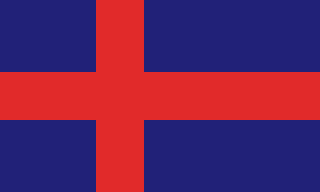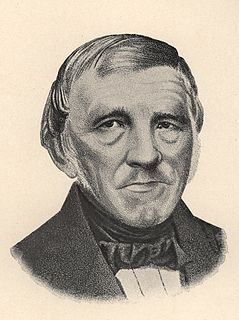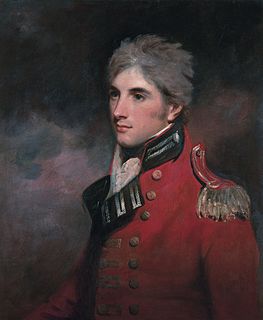John Lewis Tiarks, FRS (born Johann Ludwig Tiarks, 10 May 1789 – 1 May 1837) was the British astronomer to the North American Boundary Line Commission. [1]

The Canada–United States border, officially known as the International Boundary, is the longest international border in the world between two countries. It is shared between Canada and the United States, the second- and fourth/third largest countries by area, respectively. The terrestrial boundary is 8,891 kilometres (5,525 mi) long, of which 2,475 kilometres (1,538 mi) is Canada's border with Alaska. Eight Canadian provinces and territories, and thirteen U.S. states are located along the border.
Tiarks was born in the town of Jever, then in the Grand Duchy of Oldenburg, and now in Lower Saxony, Germany. He entered the University of Göttingen to study theology but transferred to the mathematics course. Having gained his degree he initially moved to Hamburg, but then moved to England in 1810 to escape Napoleon. There he secured employment as Assistant Librarian to Sir Joseph Banks.

Jever is the capital of the district of Friesland in Lower Saxony, Germany. The name Jever is usually associated with a major brand of beer which is produced there. The city is also a popular holiday resort. Jever was granted city status in 1536. Unofficially Jever is sometimes referred to as Marienstadt in reference to Maria of Jever, the last independent ruler of the city. The inhabitants of Jever are named Jeveraner.

The Grand Duchy of Oldenburg was a grand duchy within the German Confederation, North German Confederation and German Empire which consisted of three widely separated territories: Oldenburg, Eutin and Birkenfeld. It ranked tenth among the German states and had one vote in the Bundesrat and three members in the Reichstag.

The University of Göttingen is a public research university in the city of Göttingen, Germany. Founded in 1734 by George II, King of Great Britain and Elector of Hanover, and starting classes in 1737, the Georgia Augusta was conceived to promote the ideals of the Enlightenment. It is the oldest university in the state of Lower Saxony and the largest in student enrollment, which stands at around 31,500.
In 1817, with the help of Banks, he was appointed British Astronomer to the Boundary Commission created by the Treaty of Ghent in 1814 to resolve the border between the United States and Canada westward from the Great Lakes to the Rockies. Between 1818 and 1821 he carried out a number of specific surveys along the proposed border. He married in 1822 and returned to England.

The Treaty of Ghent was the peace treaty that ended the War of 1812 between the United States of America and the United Kingdom of Great Britain and Ireland. Both sides signed it on December 24, 1814, in the city of Ghent, United Netherlands. The treaty restored relations between the two nations to status quo ante bellum, restoring the borders of the two countries to the lines before the war started in June 1812. The treaty was approved by the UK parliament and signed into law by the Prince Regent on December 30, 1814. It took a month for news of the peace treaty to reach the United States, during which American forces under Andrew Jackson won the Battle of New Orleans on January 8, 1815. The Treaty of Ghent was not fully in effect until it was ratified by the U.S. Senate unanimously on February 17, 1815. It began the more than two centuries of peaceful relations between the U.S. and Britain, although there were a few tense moments such as the Trent Affair in 1861.
Due to delays in proceeding with the border project, the British Admiralty asked him in the meantime to determine the longitude of various European locations, such as Madeira, with the help of chronometers, for which the SS Comet had been specially outfitted. He was joined from 30 June to 17 August 1824 by Humphry Davy who used the voyage to Norway to test his zinc protectors for ships' bottoms. [2] In 1825 Tiarks was elected a Fellow of the Royal Society as "a person well versed in mathematics and nautical astronomy". [3]
HMS Comet, a wood-hulled paddle tug completed in 1822, was the first steam ship built for the Royal Navy.

Sir Humphry Davy, 1st Baronet was a Cornish chemist and inventor, who is best remembered today for isolating, using electricity, a series of elements for the first time: potassium and sodium in 1807 and calcium, strontium, barium, magnesium and boron the following year, as well as discovering the elemental nature of chlorine and iodine. He also studied the forces involved in these separations, inventing the new field of electrochemistry. In 1799 Davy experimented with nitrous oxide and was astonished at how it made him laugh, so he nicknamed it "laughing gas", and wrote about its potential anaesthetic properties in relieving pain during surgery.

Norway, officially the Kingdom of Norway, is a Nordic country in Northern Europe whose territory comprises the western and northernmost portion of the Scandinavian Peninsula; the remote island of Jan Mayen and the archipelago of Svalbard are also part of the Kingdom of Norway. The Antarctic Peter I Island and the sub-Antarctic Bouvet Island are dependent territories and thus not considered part of the kingdom. Norway also lays claim to a section of Antarctica known as Queen Maud Land.
In 1825 he was sent again to North America to ascertain the co-ordinates of the most north-westerly point of the Lake of the Woods, enduring many privations in that remote wilderness. On completion he returned to England to be sent in 1828 to the Netherlands, where the King of the Netherlands was arbitrating on the border issue.

Lake of the Woods is a lake occupying parts of the Canadian provinces of Ontario and Manitoba and the U.S. state of Minnesota. It separates a small land area of Minnesota from the rest of the United States. The Northwest Angle and the town of Angle Township can be reached from the rest of Minnesota only by crossing the lake or by traveling through Canada. The Northwest Angle is the northernmost part of the contiguous United States. Its "northwesternmost point" served as a problematic landmark in treaties defining the international border.
In 1835 his health broke down and he died in 1837 at age 48.









